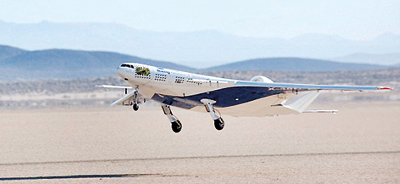Sunday Times 2
The future of air travel
Nasa has successfully demonstrated a working prototype of the ‘plane of the future’ – although it may be a step back for travellers who love a window seat.The British-built plane is a radical re-design of the traditional ‘fixed-wing’ plane shape which has seen us through 50 years of passenger air-travel, with NASA and Boeing saying we have reached the limits in terms of speed and fuel efficiency with current models.
Nasa yesterday took a scale replica of the plane for a ‘test fly’, and hopes the plane will become the next universally adopted design within the next two decades.
Scroll down for video
The X-48C is a ‘hybrid wing-body’ plane, which offers greater internal volume for passengers and cargo, and the triangle-shaped plane, reminiscent of spy planes, cuts through the air more efficiently.With a 21-foot wingspan, the 500-pound aircraft is an 8.5 percent scale model of a heavy-lift, subsonic airplane with a 240-foot wingspan that could be developed in the next 15 to 20 years for military applications and potentially consumer flights.
The model X-48C can fly for 35 minutes and has a top altitude of 10,000 feet. Yesterday’s test-run was only nine minutes long, but it was long enough for NASA to deem it a ‘successful’ test, with the space agency planning to test the plane again later this week.

Boeing chief engineer Normal Princen said fuel efficiency has increased by around 50 percent since the panes of the late 1950s, but in order to improve further ‘you have to make a radical shift in the shape of a plane’.Other benefits of the improved shape include reduced noise.
Program manager Bob Liebeck, Boeing’s senior technical fellow, said: ‘Working with NASA, we are very pleased to enter into the next flight-test phase of our work to explore and validate the aerodynamic characteristics and efficiencies of the Blended Wing Body concept.
‘In our earlier flight testing of the X-48B, we proved that a BWB aircraft can be controlled as effectively as a conventional tube-and-wing aircraft during takeoffs and landings and other low-speed segments of the flight regime.
‘With the X-48C, we will be evaluating the impact of noise shielding concepts on low-speed flight characteristics.’
The test vehicle was designed by Boeing and built by Cranfield Aerospace Ltd., in the United Kingdom, in accordance with Boeing requirements.
The X-48C is an evolution of the X-48B, which made 92 flights between 2007 and 2010.The main changes were moving the winglets to the top of the fuselage next to the engines and extending the aft deck of the airplane.
Both of these changes were part of the new design’s aim at reducing noise from the engines. And the number of engines on the X-48 has been reduced from three to two, each producing 89 pounds of thrust.
Engineers from Boeing will be working with NASA engineers during flight tests of the X-48C, which will continue throughout 2012.
© Daily Mail, London
comments powered by Disqus





















